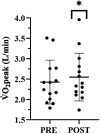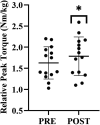Impact of exercise video-guided bodyweight interval training on psychophysiological outcomes in inactive adults with obesity
- PMID: 40247925
- PMCID: PMC12003972
- DOI: 10.3389/fphys.2025.1527171
Impact of exercise video-guided bodyweight interval training on psychophysiological outcomes in inactive adults with obesity
Abstract
Purpose: Determine the impact of a 6-week YouTube-instructed bodyweight interval training (BW-IT) program on cardiometabolic health, muscular strength, and factors related to exercise adherence in adults with obesity.
Methods: Fourteen adults (30.7 ± 10.3 yrs, BMI 35.5 ± 5.4 kg/m2) participated in this study. The BW-IT program progressed bi-weekly from a 1:3 to 1:1 work-to-rest ratio, using maximum effort intervals of high knees, squat jumps, scissor jacks, jumping lunges, and burpees. Pre- and post-intervention measures included peak oxygen consumption ( O2peak), relative quadriceps isometric muscular strength, waist circumference (WC), body composition via bioelectrical impedance, and cardiometabolic blood markers (blood glucose, insulin, lipid panel, and C-reactive protein). Self-efficacy (task and scheduling) and physical activity enjoyment (PACES) were also assessed.
Results: Relative isometric muscular strength increased by 12.5% (p = 0.02, dz 0.4) and absolute O2peak by 4.2% (p = 0.03, dz = 0.2). WC reduced by 2.1% (p < 0.001, dz = 0.2). Task self-efficacy was similar pre- to post-intervention (p = 0.53, dz = 0.2), while scheduling self-efficacy was reduced (p < 0.004, dz = 1.1). PACES scores were 9.6% higher week one compared to week six of BW-IT (p = 0.003, dz = 0.6). No changes occurred in body composition or cardiometabolic blood markers.
Conclusion: In previously inactive adults with obesity, 18 sessions of YouTube-instructed bodyweight interval training elicited small to moderate effects on lower extremity muscular strength, cardiorespiratory fitness, and waist circumference. Future studies may benefit from longer interventions and adding a greater variety of calisthenics to determine interventions that improve physiological health and maintain or enhance factors associated with exercise adherence.
Keywords: bodyweight exercise; cardiorespiratory fitness; enjoyment; interval training; muscular strength; obesity; self-efficacy.
Copyright © 2025 Bellissimo, Bailly, Bourbeau, Mermier, Campitelli, Berkemeier, Specht, Smith, Ducharme, Stork, Little, Kravitz, de Castro Magalhães, Gibson and Amorim.
Conflict of interest statement
The authors declare that the research was conducted in the absence of any commercial or financial relationships that could be construed as a potential conflict of interest.
Figures
References
-
- Abildso C. G., Daily S. M., Umstattd Meyer M. R., Perry C. K., Eyler A. (2023). Prevalence of meeting aerobic, muscle-strengthening, and combined physical activity guidelines during leisure time among adults, by rural-urban classification and region—United States, 2020. MMWR. Morb. Mortal. Wkly. Rep. 72 (4), 85–89. 10.15585/mmwr.mm7204a1 - DOI - PMC - PubMed
-
- Al-Mhanna S. B., Batrakoulis A., Mohamed M., Alkhamees N. H., Sheeha B. B., Ibrahim Z. M., et al. (2024). Home-based circuit training improves blood lipid profile, liver function, musculoskeletal fitness, and health-related quality of life in overweight/obese older adult patients with knee osteoarthritis and type 2 diabetes: a randomized controlled trial during the COVID-19 pandemic. BMC Sports Sci. Med. Rehabilitation 16 (1), 125. 10.1186/s13102-024-00915-4 - DOI - PMC - PubMed
-
- Bandura A. (1997). Self-Efficacy: the exercise of control, 604. NewYork, NY: Freeman.
LinkOut - more resources
Full Text Sources
Research Materials



